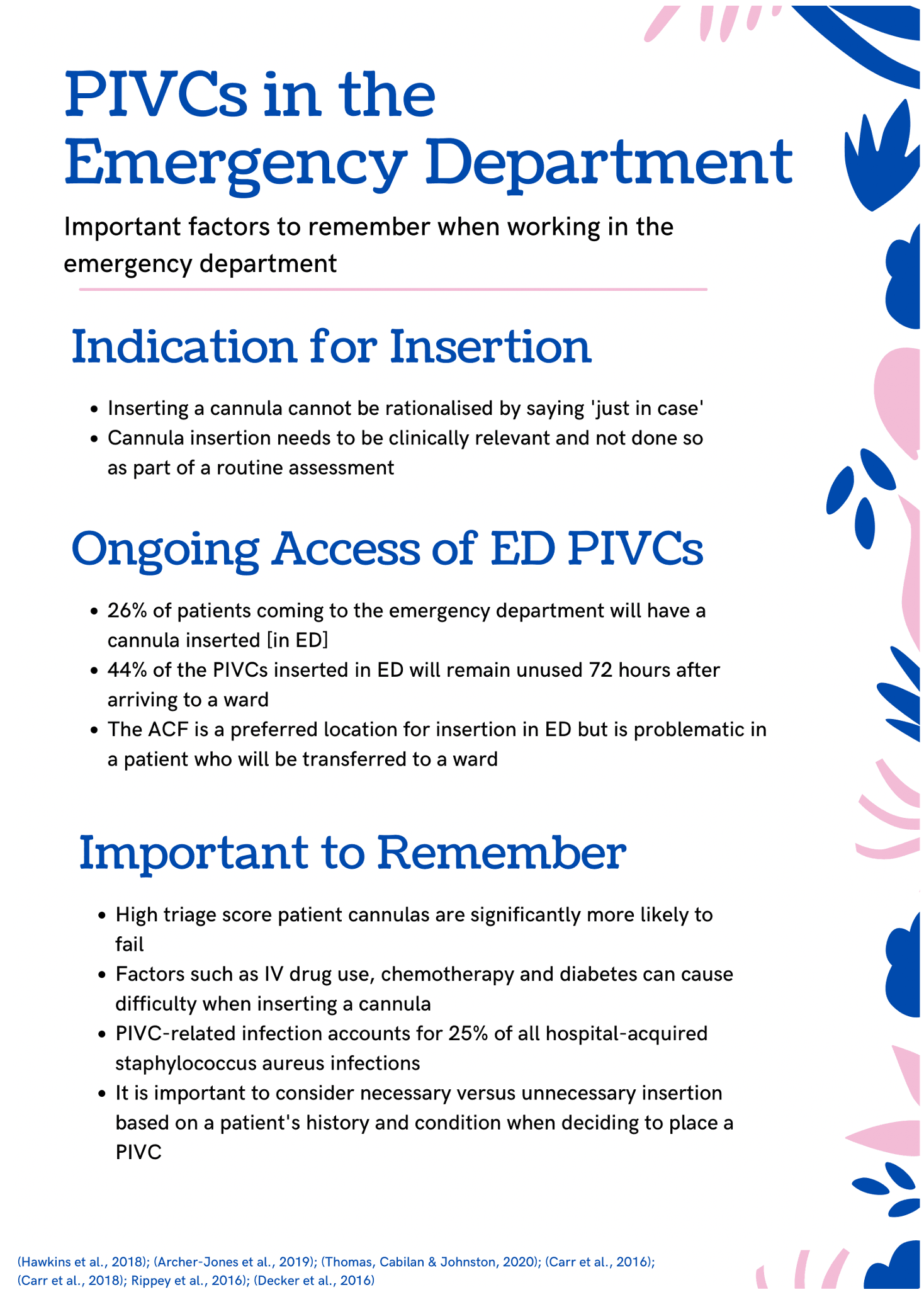PIVCs in the Emergency Department
)
The emergency department is a fast-paced, hectic and often unpredictable environment. In the 2019-2020 financial year, Australian EDs treated 8,236,159 patients, reviewing an average of 22,600 patients per day (1). Often working under duress and having to make clinical decisions within a very narrow timeframe, ED clinicians must quickly identify what a critically unwell patient needs in order to be stabilised (2,3).
Achieving vascular access usually means urgent insertion of a peripheral intravenous catheter (PIVC). However, higher triage scores (i.e., category one) significantly reflect PIVC failure rates and necessitate PIVC reinsertion within 24 hours due to the increased infection risk (4).
For the majority of patients coming into the ED not identified as a category one, PIVC insertion should be a measured decision that fully assesses the need for the device and potential risks for a patient. One-quarter of patients in the ED have a PIVC inserted. Many are clinically indicated, such as for administration of medication, blood products or fluids, but many are inserted "just in case the patient deteriorates" (5,6). Given that as many as 50% of PIVCs inserted in patients subsequently admitted to an inpatient ward remain unused after 72 hours (7,8,9), ED clinicians must question whether a PIVC is going to be used beyond drawing blood at the time of insertion (10).
'Just in case' is not a reason to insert a PIVC. PIVCs pose a high risk of side effects, from localised swelling and phlebitis to a significant risk of bloodstream infection, especially if stringent precautions are not taken when inserting or accessing the device (11).
Approximately 25% of all incidents of Staphylococcus aureus infection are directly caused by PIVCs, presenting a significant implication to the patient and, fiscally, to the hospital (6). As such, where available, clinicians working in the ED need to evaluate whether a PIVC is best for the patient, and whether the PIVC is likely to be used after taking blood at the time of insertion (12,13). If not, take the blood via venipuncture and insert a PIVC only if medically required.
This poster highlights some important things for ED clinicians to remember, such as PIVC placement, factors influencing access, and important statistics.
References
1. Australian Institute of Health and Welfare. (2020). Emergency Department Care Activity. AIHW. https://www.aihw.gov.au/reports-data/myhospitals/intersection/activity/ed
2. Carr, P., Rippey, J., Budgeon, C., Cooke, M., Higgins, N., & Rickard, C. (2016). Insertion of peripheral intravenous cannulae in the Emergency Department: factors associated with first-time insertion success. Journal of Vascular Access, 17(2), 182-190.
3. Carr, P., Rippey, J., Cooke, M., Bharat, C., Murray, K., Higgins, N., . . . Rickard, C. (2016). Development of a clinical prediction rule to improve peripheral intravenous cannula first attempt success in the emergency department and reduce post insertion failure rates: the Vascular Access Decisions in the Emergency Room (VADER) study protocol. British Medical Journal, 6(2), e009196.
4. Carr, P., Rippey, J., Cooke, M., Higgins, N., Trevenen, M., Foale, A., & Rickard, C. (2018). From insertion to removal: A multicentre survival analysis of an admitted cohort with peripheral intravenous catheters inserted in the emergency department. Infection Control and Hospital Epidemiology, 39(10), 1216-21.
5. Archer-Jones, A., Sweeny, A., Schults, J., Rickard, C., Johnson, L., Gunter, A., & Watkins, S. (2019). Evaluating an ultrasound-guided peripheral intravenous cannulation training program for emergency clinicians: An Australian perspective. Australasian Emergency Care, 23(3), 151-156.
6. Hawkins, T., Greenslade, J., Suna, J., Williams, J., Rickard, C., Jensen, M., . . . Cullen, L. (2018). Peripheral cannula insertion and use in the emergency department: an intervention study. Academic Emergency Medicine, 25(1), 26-32.
7. Limm, E., Fang, X., Dendle, C., Stuart, R., & Warburton, D. E. (2013). Half of all peripheral intravenous lines in an australian tertiary emergency department are unused: pain with no gain? Annals of Emergency Medicine, 62(5), 521-525.
8. Gledstone-Brown, L., & McHugh, D. (2018). Review article: Idle 'just-in-case' peripheral intravenous cannulas in the emergency department: Is something wrong? Emergency Medicine Australasia, 30(3), 309-326.
9. Steel, M., & Goodacre, S. (2016). The impact of peripheral intravenous (IV) cannulation in the ambulance and emergency department. Emergency Medicine Journal, 33(12), 905.
10. Thomas, C., Cabilan, C., & Johnston, A. (2020). Peripheral intravenous cannula insertion and use in the emergency department: an intervention study. Australasian Emergency Care, 23(3), 166-172.
11. Australian Commission on Safety and Quality in Health Care. (2021) Management of Peripheral Intravenous catheters clinical care standard. ACSQHC: Sydney. https://www.safetyandquality.gov.au/publications-and-resources/resource-library/management-peripheral-intravenous-catheters-clinical-care-standard
12. Decker, K., Ireland, S., O'Sullivan, L., Boucher, S., Kite, L., Rhodes, D., & Mitra, B. (2016). Peripheral intravenous catheter insertion in the Emergency Department.Australasian Emergency Nursing Journal, 19, 138-142.
13. Rippey, J., Carr, P., Cooke, M., Higgins, N., & Rickard, CM. (2016). Predicting and preventing peripheral intravenous cannula insertion failure in the emergency department: clinician 'gestalt' wins again. Emergency Medicine Australasia, 28(6), 658-665.
| Tags:peripheral intravenous catheterinfection preventioninsertionvascular access devices |








